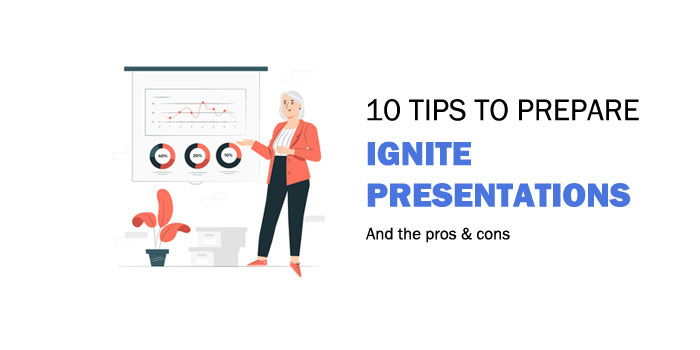Ignite Presentation: How to Prepare and Deliver a Successful One
Are you wondering how to captivate your audience and convey essential concepts in just a few minutes? If so, try an Ignite presentation.
Typically, an Ignite presentation is a format in which a presenter shares information while slides automatically advance to support the presenter. Nowadays, Ignite presentations are becoming popular due to the rise of technology.
Crafting a good presentation, it’s not that easy. Therefore, as a presenter, you must do everything possible to ensure that your audience captures everything.
In addition, you don’t want to keep your audience for long, and thus mastering the tricks to create an Ignite presentation is essential. For that, you first need to understand the origin, working, and formats of Ignite presentations.
What Is an Ignite Presentation?
An Ignite presentation is a format in which the speaker presents information with the support of slides that advance automatically. Ignite is promoted under the slogan, “Enlighten us, but make it quick.”
An Ignite presentation usually takes five minutes and contains twenty slides. Each slide is automatically displayed for fifteen seconds while the presenter delivers the information. The result of this process is more enjoyable and engaging.
If the Ignite presentation is done accordingly, this style is the best for conveying information in many situations. You can use it in classroom presentations, conference events, and toastmasters’ meetings to engage your audience maximumly.
Since we know what Ignite presentation is, let’s now look at its history from when it started, how it evolved, and some examples.
Brief History and Examples of Ignite Presentation
Bre Pettis and Brady Forrest held the first Ignite presentation in Seattle, Washington, in 2006.
During this time, the Make Magazine and O’Reilly Media sponsored Ignite. In November 2015, O’Reilly handed off the franchise to Brady Forrest, the founder.
Thereafter, the founder introduced Ignite talks. Ignite presentation has spreaded over 350 teams in schools, government, and private institutions.
Since the time Ignite presentation was introduced, it has helped most presenters, including teachers.

For example, most students have difficulty staying on a topic. Therefore, with the help of Ignite presentations, it gives a clear guide and a great way to teach students how to strengthen their presentation skills.
Ignite is short and focuses to a point with no sound or animations, thus suitable for students. Indeed, the introduction of Ignite presentations has helped combine big ideas and networking.
Though Ignite presentations began in the technology industry, not all of them are tech-based. The following are examples of Ignite presentations that you can look at to gather ideas:
- The Illusion of Speed”, at Velocity 2013, by Steve Souders
- Jane the Concussion Slayer, by Jane McGonigal
- Getting Past Hello How to Talk to Anyone, by Bethany Marzewski’s
Either way, if you want to sharpen your skill in creating and delivering a successful Ignite presentation, below are the tips to consider.
How to Create and Deliver a Successful Ignite Presentation: Step by Step
It is evident that Ignite presentation is an essential tool to deliver your idea in a friendly and engaging manner that doesn’t bore your audience. Thus, you need to master and practice the skills on how to create an Ignite presentation.
1. Start Early and Do Research
To narrow down a specific topic to a short presentation can take a long time than you think. Therefore, you can try combining strategic and big image thinking. This way, your audience will capture everything in a short time.
Do research as much as possible to know how to visualize an Ignite presentation. Remember, an Ignite presentation only takes five minutes. So, it’s best if you do thorough research to avoid wasting your time while on the stage.
2. Don’t Shorten a Longer Presentation
A presenter can try to condense a full-length presentation into an Ignite speech during a presentation. The best thing to do if you plan to use the existing material is to cut them rather than condense them.
This helps the presenter focus on the main points relevant to the audience. In fact, the reason why many smart presenters deliver bad presentations is that they use a lot of points and irrelevant materials. So, it’s good to shorten long presentations by taking only relevant topics.
3. Have One Idea per Slide
Depending on the length of the presentation, it’s good to use one idea on every slide. The idea must be delivered along with bold visuals and two to three narration sentences.
4. Visualize Your Slides
Once again, visualizing slides, including an Ignite speech, is very important in any presentation. This is because the audience has only fifteen seconds to capture every point. Therefore, making it hard for them to read the words displayed on the screen and listen to what you are saying simultaneously.
For that reason, presenters are advised to follow the 6/6 rule. The rule states that you should have less than 6 lines per slide and less than six words per slide. So, try to use a few words on your slides or avoid using the words as well.

5. Be Flexible
To manage time, try to be flexible by adjusting your time, slowing down, and increasing the speed here and there during the Ignite speech topics.
Slow down when you are emphasizing and speed up where a presentation needs momentum. Of course, the pace you use should match your content.
6. Script Your Speech
Scripting your presentation helps you to avoid “winging it.” Speech scripting is the best and safe way to deliver a successful and friendly Ignite talk. You can carry notes if scripting is allowed.
7. Practice
Rehearsal is essential before any presentation. The best way to rehearse is by reading with notes.
Set your slides to automatically slide every fifteen seconds to see your timer and notes. Run it as many times as possible until you get the right timing. This will help you anticipate the time in which your slides will change.
Secondly, practice without notes by running your presentations to see how they will work. After that, stop the clock on the screen to get used to it because you can lack a visible timer when on the stage. Lastly, practice without the slides repeatedly.
8. Narrate a Story
Even if your presentation is not story-like, find a story relevant to your topic. A story makes the session exciting and easy to understand.
Most Ignite presentation that works well are funny with engaging stories.
9. Be Ready to Answer Questions
As a speaker, you must make a list of questions that you can expect from your audience. Remember that your audience might have questions about the presentation, so it’s good to be ready.
10. Carry On
Relax, and breathe while on the stage, and then carry on. Remember to keep moving forward and avoid dwelling on negatives, especially when a mistake happens. In addition, space yourself as you don’t need to talk for the entire fifteen seconds.
In fact, you can use one wordy slide without saying anything letting your audience read for themselves. This way, you will give the audience a good time for the points to sink in. Furthermore, the audience will feel more relaxed and less tense when watching you.
Finally, master all the Ignite presentation formats, and you will conquer anything while on the stage.
Main Types of Ignite Presentations
There are many types of Ignite presentations, including the following:
1. Persuasive Presentations
A persuasive presentation is an Ignite presentation where a speaker convinces the audience to do something. Persuasive presentations can be challenging because you must persuade the audience to accept your ideas and take the necessary actions.
However, as a speaker, you can use some skills like storytelling to convince your audience. An example of a persuasive Ignite presentation is where a speaker tells the audience to start a specific business.
2. Instructional Presentation
This is where you give specific orders or instructions to the audience. For instance, an HR manager can hold a board meeting to instruct employees on the rules and regulations.
3. Informative Presentations
Informative presentations give some information about a particular topic. For example, business presentations and seminars can be categorized as informative presentations.
Advantages of Ignite Presentation
There are countless advantages inherent in this presentation style. They include:
1. Emphasize Content Decision
The Ignite presentation helps a presenter to eliminate tough decisions about her speech execution.
Moreover, spending more time on speeches allows the presenter to pinpoint critical information. Besides, it helps in explaining the main ideas avoiding rambling aimlessly.
2. Respecting the Audience’s Time
Most speakers ignore the time limit. Therefore, presenters keep the presentation time by having a self-playing presentation style.
For example, if a teacher uses the typical presentation, the students may speak longer than the allocated time. But if the teacher uses an Ignite presentation, students will stick to the five minutes given.

However, the Ignite presentation format doesn’t guarantee that a presenter will precisely finish the presentation within five minutes.
3. Encourages Concision
Due to the short time given and with twenty slides, the speaker must know how to arrange the presentation.
For example, you can cut and reduce the ads in your presentation if they are long. This will make your presentation effective, and the audience will receive and capture only the vital information.
4. Improves Communication Skills
When preparing an Ignite presentation, you must think well about a good framework and persuasive strategy.
Therefore, this helps you improve your communication skills. You can learn how to present your information and ideas in a suitable format and coherent manner.
5. Form Social Connections
Finally, Ignite presentation makes the people come together to share different interests.
As a speaker, many people approach you after the presentation, where you can engage in a conversation. Moreover, people can interact freely after the presentation to share their ideas about the Ignite speech topics.
Disadvantages of Ignite Presentation
Despite having several benefits, an Ignite presentation has some drawbacks, which include:
1. Limited Time
The fixed timing in an Ignite presentation can be very challenging for a speaker.
For instance, if your Ignite presentation is long, it means that it cannot be delivered within five minutes. In this case, you can try to cut irrelevant information to shorten it.
2. Lack of Audience Interaction
Ignite presentation runs automatically, and the presenter lacks time to interact with the audience during the presentation.
However, the speaker can interact with the audience after the speech since the Ignite presentation is short.
3. Technical Issues
Despite being a good presentation format, sometimes it can be ineffective due to technical delays. This can hamper your presentation and make your audience bored while trying to fix the problems.
4. Lack of Purpose
Presentation technologies aren’t necessary sometimes.
For example, building a slide presentation without real substance can harm the presentation’s impact. Furthermore, listing keywords aimlessly on slides may confuse the audience instead of helping them. Eventually, the audience will wonder about the idea of your presentation.
Conclusion: Ignite Presentation Pros & Cons
To keep your Ignite presentation on track, each slide must have strong points and relevant supporting topics.
Remember that you should try to make your audience understand what you are presenting. Otherwise, your audience can get lost when you make your Ignite speech topics hard to follow.
In addition, you must follow the Ignite presentation format when preparing your Ignite presentation and while on stage.
For example, you should learn how to visualize your slides and how to script your Ignite speech. But that should not worry you because this guide has everything you need to know about Ignite presentation.
Follow all the instructions, and you will deliver nothing but an enjoyable, engaging, and friendly Ignite presentation that won’t be monotonous to your audience.
